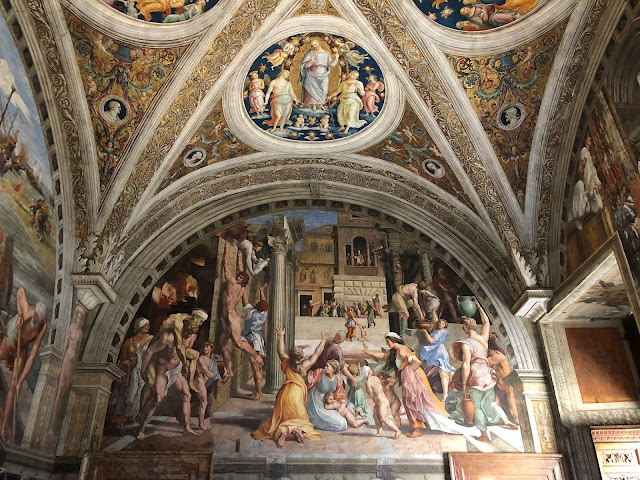【ローマ】ヴァチカン ボルゴの火災の間 Roma - Musei Vaticani, Stanza dell'Incendio de Borgo
続いては、ボルゴの火災の間。この部屋に描かれているラファエロの絵の名前が、この部屋の名前になっている。
ユリウス2世の時代には、この部屋は裁判のために使われていた。
レオ10世は、この部屋を身近な人々を食事を取るための小さな食堂として改装させた。
すでに、ユリウス2世の命によって、ペルジーノが天井部分の絵画を描き始めていたが、レオ10世はその仕事をラフェエロに引き継がせた。
Next is the room of the Borgo fire. The name of Raphael's painting in this room is the name of this room.
During the time of Pope Julius II, this room was used for trials.
Leo X refurbished this room as a small dining room for people close to him to eat.
Already, at the behest of Pope Julius II, Perugino had begun painting the ceiling, but Leo X took over the work to Lafeero.
この部屋の名前にもなっている、『ボルゴの火災』。
8世紀から9世紀にかけて教皇だったレオ3世が、十字を切る身振りだけで、当時のローマの新開地(ボルご)の火事を消した、というエピソードが描かれている。
ラファエロの絵といえば、『アテネの学堂』に代表されるように、左右対称の構図で描かれる絵が多かったが、この部屋の絵画はでは、描かれているテーマに合わせてダイナミックな画面構成になっている。
背後の建物の窓に、十字を切るレオ3世の姿が小さく描かれているが、この建物はコンスタンティヌス帝に建てられた、かつてのサン・ピエトロ大聖堂で、その面影を伝えている。
"Fire in the Borgo", which is also the name of this room.
An episode is depicted in which Pope Leo III, who was the Pope from the 8th to 9th centuries, extinguished the fire in Rome's Shinkaichi (Borgo) at that time simply by gesturing to cut a cross.
Speaking of Raphael's paintings, many of them were drawn with a symmetrical composition, as represented by "The School of Athens", but in this room, the paintings have a dynamic screen composition according to the theme being drawn. It has become.
In the window of the building behind, a small figure of Pope Leo III cutting a cross is drawn, which is a remnant of the former St. Peter's Basilica built by Emperor Constantine.
『オスティアの戦い』には、サラセン人との戦いに勝ったレオ4世を描いているが、その姿は絵の注文主のレオ10世のようだ。
ラファエロはこの部屋の制作を手がけている途中、1520年に突然の死を遂げた。
この絵の下絵はラファエロ自身が描いたが、この絵自体を完成させたのは弟子のジュリオ・ロマーノだった。
"Battle of Ostia" depicts Leo IV, who won the battle with the Saracens, but it looks like Leo X, the orderer of the painting.
Raphael died suddenly in 1520 while working on the room.
Raphael himself drew the sketch of this painting, but it was his disciple Giulio Romano who completed the painting itself.
『カール大帝の戴冠』は、歴史上有名な西暦800年に行われたレオ3世によるカール大帝への戴冠が描かれている。
ここでも背景に描かれているのは、かつてのサン・ピエトロ寺院の内部の様子。
レオ3世はレオ10世の姿で、戴冠を受けるカール大帝はフランソワ1世の姿で描かれている。
この絵を描かせたレオ10世は、かつて同じ名前を持つレオ3世がカール大帝にしたように、当時の有力なフランス王だったフランソワ1世を自分の味方につけたいと考えていたのだろう。
この絵は、ラファエロの弟子のうち、誰によって描かれたのかはわかっていない。
"Charlemagne's Coronation" depicts the historically famous coronation of Charlemagne by Pope Leo III in 800 AD.
Again, the background is the interior of the former St. Peter's Basilica.
Leo III is depicted as Leo X, and the crowned Charlemagne is depicted as Francis I.
Leo X, who drew this picture, wanted to have Francis I, the influential King of France at the time, on his side, just as Leo III, who had the same name, once made Charlemagne. Let's go.
It is unknown who of Raphael's disciples painted this painting.
天井部分には、ラファエロがこの部屋を手がける前の、ペルジーノのよって描かれた4つの絵がそのまま残されている。
On the ceiling, four paintings by Perugino before Raphael worked on this room are left as they are.
ラファエロが手がけた最後の装飾作品となったこの部屋は、期せずしてかつての師匠との共演の場となった。
This room, which was Raphael's last decorative work, unexpectedly became a place for co-starring with his former master.
ラファエロによる、歴史上の事件をテーマにダイナミックな絵に比べると、そのテーマの違いということもあるが、ペルジーノの絵の世界は実に優美に描かれている。
Compared to Raphael's dynamic paintings on the theme of historical events, the world of Perugino's paintings is truly graceful, although it may be a difference in the theme.
この他にも、キアロスクーリの間、コンスタンティヌスの間という2つの部屋があるが、すでにラファエロは亡くなっていたの、それらの絵はラファエロの構想に基づいて、ジュリオ・ロマーノなどのラファエロの弟子たちや別な画家たちによって描かれたものだ。
In addition to this, there are two rooms, the Chiaro Scuri room and the Constantine room, but Raphael has already died, and those paintings are based on Raphael's conception, and are different from Raphael's disciples such as Giulio Romano. It was painted by various painters.









コメント
コメントを投稿